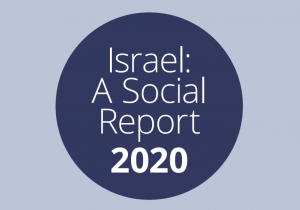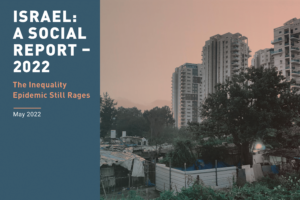It’s high time for a turnabout in public policy that places the public interest at the center. This is the bottom line of Adva Center’s annual flagship report
It’s high time for a turnabout in public policy that places the public interest at the center.
Thirty-five years ago, on July 1, 1985, the national unity government led by the Labor and Likud parties announced an emergency stabilization plan, which came to be known as the program that reduced inflation from three digits to two. The plan called for reducing the role of government in the economy, for adopting economic growth as the main goal of economic policy and for transferring responsibility for economic growth from government to the business sector. Economists praised the change to “an economy based more and more on market forces and open to the whole world.” The CFO of the Ministry of Finance crowned the date as “the economic independence day of Israel.”
The data presented in the present report question the accepted wisdom that “an economy based more and more on market forces” is obviously best.
Economic growth did indeed become the main goal of economic policy, but today it has become abundantly clear that growth alone does not necessarily lead to an improvement in the general standard of living. During most of the last three decades, GDP per capita grew faster than wages. In other words, the economy grew, but most people did not benefit from economic growth as expected.
Free market forces led, among others, to the development of a stratum of families and business groups that accumulated wealth and public power enabling them to influence the directions of Israel’s economic development, its taxation policy and its employment patterns. We are speaking of the “top one percent” and within it, the top 0.01 percent – about which there are no official statistics, and thus the whole picture of inequality in Israel is sorely skewed.
The emergency stabilization plan did reduce the weight of government in the economy; in actuality, it succeeded over and above, as today government civilian expenditure in Israel is among the lowest among OECD countries. The concrete result is that the government does not fund social services like health and education at the same level as western European countries. Instead, the burden of payment is transferred to individual pockets, especially those of the middle class.
Another stratum, comprising a little more than a fourth of the population, is of persons living in poverty or near poverty. This stratum, which during the years 2006-2009 comprised 28.3% of Israeli households, declined to 26.0% in 2018. Still, the poverty rate in Israel is one of the highest among OECD countries.
The present report is based on household expenditure surveys of the Israel Central Bureau of Statistics. These data are adequate when it comes to the population as a whole, as income disparities within each income decile are narrow. But the data are sorely lacking when it comes to the top one percent, which includes both millionaires and billionaires.
Shlomo Swirski, one of the authors of the report, calls for “placing the public interest at the center of public policy. This does not involve weakening the business sector, but rather strengthening the arms of the state. The national budget,” Swirski adds, “needs to include engines of equality and not just engines of economic growth. The Israeli government needs to invest in regions of the country neglected by the business sector. It needs to establish higher wage norms for minimum wage earners employed in its own services. The Israeli government needs to upgrade the public education system and increase higher education opportunities. It needs to deal with the growing needs of the public health system and to halt the process of privatization taking place within it. It needs to develop a public housing option for long-term rentals, and to strengthen the social safety net.”
Following are selected figures from Israel: A Social Report 2020:
- Greatest Growth: The Top One Percent: The average income of the top one percent of Israeli households headed by salaried persons – NIS 138,000 per month (2018), is not only 8 times higher than the average income of the middle (fifth) income decide, but also 2.4 times higher than the average income of the remaining 9 percent of the top income decile.
- A comparison between the top one percent, the top income decile (10%) without the top one percent, and the middle (fifth) income decile for the years 2012-2018 reveals that the income of all three groups increased; at the same time, between 2016 and 2018 the income of the top one percent increased by 20% while that of the two other groups increased by 10%.
- Total Household Income: Top Income Decile Gets 12 Times Bottom Decile: There are four sources of household income: wages, capital, income transfers and pensions. In 2018, the average monthly gross income of households headed by salaried persons from all four sources amounted to NIS 66,584. This sum is 12 times the income of households in the bottom income decile – NIS 5,501.
- Salary Growth Lags Behind GDP Growth: During the two decades between 1968 and 1989, GDP growth was accompanied by a parallel growth in real salaries. However, beginning in the 1990s, the paths of growth diverged, with GDP per capita increasing more than the average salary.
- More than 20% of Israelis Earn Low Wages: According to data published by the OECD for 2017, 22.6% of wage earners’ pay was considered low. This figure is high, compared those of other OECD countries, in which the average is 15.4%. The OECD defines low wages as not exceeding two-thirds of the median wage; it includes only persons working full-time.
- Increase in Minimum Wage Earners: In 2017, the proportion of Israelis receiving no more than the minimum wage was 33.6%. Two years before, in 2015, the proportion was 30.8%, evidence that many of the new jobs created are paying no more than the minimum wage.
- Largest Increase in Minimum Wage Earners – in Arab Localities: The proportion of persons making no more than the minimum wage grew in all locality groups; the largest increase was in Arab localities. Following is the proportion of minimum-wage earners by locality groups: Haredi settlements – 55%; Arab localities – 45%; development towns – 37%; non-Haredi settlements – 31%; affluent localities – 26%.
- Salary Pyramid by Ethnic Origin and Gender – No Change for the Better: In 2018, Ashkenazi first-generation men who immigrated to Israel prior to 1989 topped the scale, with an average wage of NIS 18,772; following were second-generation Ashkenazi men, with NIS 16,483; second generation Mizrahi men, with NIS 14,153, first generation Mizrahi men, with NIS 13,578; Ashkenazi men who immigrated after 1990, with NIS 13,179; and first generation Ashkenazi women who immigrated before 1989, with NIS 11,918. At the bottom: Arab women and Jewish women of Ethiopian extraction – NIS 5,722 and NIS 5,619, respectively.
- In 2018 Nearly Half of Elderly Households Had No Pension Income: In 2018, fewer than half of households headed by salaried or self-employed persons in the bottom income decile were saving for retirement – 47.2%. In the second decile the percentage was 63.8%; in the third, 74.9%. In households in the fourth decile or higher the proportion was between 83% and 88%. A total of 20.7% of households were not saving for retirement in 2018. That same year, 44.7% of households headed by persons aged 67 and over had no pension income.
- Israel Has One of the Most Diminished Middle Classes in the OECD: Israel’s middle class has shrunk more than those of other OECD countries, with the exception of Estonia and Lithuania. Only 53.8% of Israeli households are considered middle class.
- 26% of Israeli Households Live in Poverty or Near Poverty: Between 2003 and 2012, households living in poverty or near poverty comprised 28% of total Israeli households. In 2016 the figure was 26.6% and in 20-18, 26.0% – about one out of four. However, it appears that part of the decrease in the poverty rate in 2018 may be attributed to insufficient sampling of the population of East Jerusalem.
- Inequality is Slightly Lower but Still High: The latest Gini Coefficient published by the National Insurance Institute is for 2018: 0.3559. This is the lowest figure registered over the last two decades. At the same time, it is still higher than that of most of the member countries of the OECD.
- Higher Education – Only One in Three Make It: Only 32.6% of young people who were 17 years old in 2010 were admitted to one of the institutes of higher learning in Israel in 2018.
- Large Disparities in Investments in Informal Education: In 2018, outlays on children up to the age of 18 for private lessons and extra-curricular activities rose with the economic status of households. In Jewish households, the average outlay for those in the top stratum was NIS 401 per month – 10 times that of poor and near poor households. In Arab households, the average monthly outlay for those in the middle stratum was about NIS 100 – 5 times that of poor households.
- Public Health System: Infant Mortality Very Low But Still Double Among Arabs: Israel’s public health system gives it an honorable place among developed countries. Infant mortality in 2017 was 3.1 for 1,000 live births, placing Israel well on the OECD scale. At the same time, in 2018 infant mortality for Arabs – 4.8 – was more than twice as high as that for Jews – 2.5.
- Supplemental medical insurance marketed by health funds and private insurance offered by insurance companies have become a huge financial enterprise: In 2000, household expenditures on both types of medical insurance, along with co-pays for medications and treatments, amounted to NIS 4.6 billion (in 2018 prices); in 2018 they totaled NIS 14.4 billion.
- 70% of Housing Rental Income Goes to Households in the Top Three Income Deciles: In 2018, rental income for housing totaled NIS 17.06 billion. Of this amount, NIS 7.18 billion was paid to households in the top income decile, NIS 3.1 billion to households in the ninth income decile and NIS 1.7 billion to households in the eighth income decile. That is, the three top income deciles received, together, 70% of the total income from housing rent, with the top income decile alone taking in 42%.




